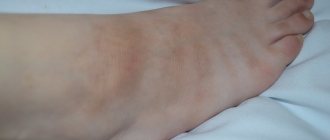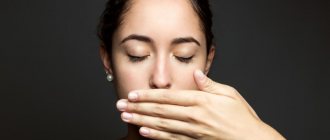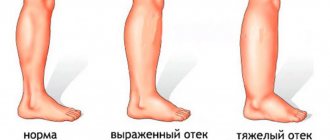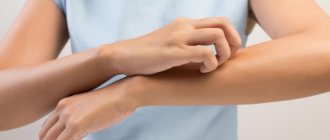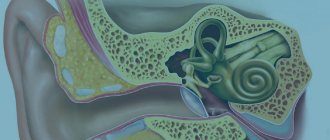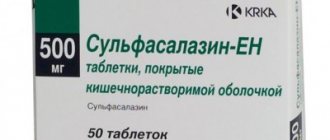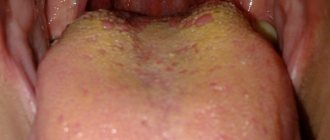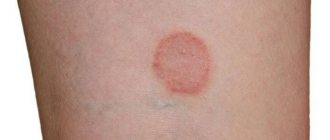Rash due to dysbacteriosis
It is almost always possible to uncover the cause of the development of a rash due to dysbacteriosis, due to its relationship with an allergic reaction. Many allergic diseases occur against the background of a disturbed composition of the intestinal microflora, such as food allergies, bronchial asthma, urticaria, eczema and some types of dermatitis.
The main reason for the appearance of a rash due to dysbacteriosis is the body's increased sensitivity to certain allergens.
Immunity is fully formed only by school age. Due to its immaturity, the child’s body is unable to cope with the activity of allergens, which, upon contact with the immune system, give a response in the form of a rash. A rash due to dysbacteriosis in adults can develop as a result of food allergies, provoked by the invasion of allergens into the body and digestive disorders. If any product is an allergen, the rash may appear constantly. The chronic form of dysbiosis against the background of food allergies is a sign of digestive disorders, while it is quite difficult to detect the irritant, so repeated reactions lead to internal and functional disorders in the digestive canal and various organs.
Diagnosis
If rashes appear due to dysbacteriosis in a baby, then it is necessary to have the stool tested.
This allows you to study the intestinal flora, but before taking the test, you need to talk to your doctor about the advisability of this study.
Among the main laboratory diagnostic methods are:
- Coprogram - the level of digestion of food in the intestines is determined, and inflammatory processes can also be noticed.
- The stool sample tank allows you to identify pathogenic bacteria in the intestines.
- Stool analysis for dysbiosis - determines the balance between beneficial and pathogenic flora.
It may seem that the diagnostic methods are simple, but for the reliability of the results you will need to do everything correctly.
To achieve this, you must follow these recommendations:
- Before collecting feces, you need to wash the child and use fresh underwear; it is recommended to use homemade diapers from diapers rather than diapers.
- Do not store feces for a long time.
- It is better to use a container for transporting and storing feces; you can buy it at the pharmacy.
- If a newborn is fed formulas that contain probiotics and prebiotics, then you need to stop giving them to the child for several days, only then collect the stool for analysis.
Such rules allow you to obtain accurate results, after which the doctor will be able to determine how to treat the rash due to dysbacteriosis in infants.
https://youtu.be/7ohXI1QGzB4
Dysbacteriosis rashes on the child's skin
It is easy to identify the cause of a rash due to dysbacteriosis, since the disease is related to an allergic reaction. Against the background of disturbances in the intestinal microflora, children often experience the development of other diseases.
Dysbacteriosis is manifested by the body's response to an irritant in the form of a rash and peeling. Causes of rashes in children include:
- artificial feeding;
- injury to the baby during childbirth;
- use of medications during breastfeeding.
Fungal infections
Antifungal drugs are used to treat fungus. These are usually ointments that are applied to the affected areas.
Such drugs are also available in the following forms:
If the fungus covers a large area of skin, you may need to take special tablets internally.
Among folk remedies, vinegar is effective against fungus. An acidic environment is not suitable for the development of fungal infections and has a negative effect on them. Should be 2 tbsp. Mix vinegar with the same amount of vodka and 3 egg whites.
Beat until smooth. Apply compresses from the resulting mixture to the affected areas. To prevent the product from disappearing, it should be stored in the refrigerator.
Symptoms of dysbiosis in infants
- The baby spits up after every feeding. In most cases, this symptom is not pathological, since it is observed in many infants. It is recommended to keep the child in an upright position for about 10 minutes after eating. With the development of dysbacteriosis, regurgitation is profuse, sometimes turning into vomiting.
- Colic and increased gas formation. These manifestations can be indicated by the child’s behavior: he is bothered by gases, he is capricious, cries, and presses his legs to his stomach.
- Abnormal stool. When dysbacteriosis occurs in an infant, constipation is replaced by diarrhea.
- Frequent constipation. When breastfeeding a baby naturally, bowel movements occur once every three days, without causing discomfort, which is the norm. When artificial feeding, emptying should be more frequent - once a day. With the development of dysbacteriosis, stool is formed much less frequently.
- Liquid green stool. With dysbacteriosis, the baby's stool may become green, contain impurities, white lumps, stool may foam and have an unpleasant odor.
- Child's anxiety. If the microflora is disturbed, the child sleeps and eats poorly and does not gain weight.
Causes of rashes due to dysbacteriosis
The appearance of rashes due to dysbacteriosis does not always indicate a relationship with allergies. In adults, the causes of the development of dysbiosis are poor nutrition, reduced immunity, previous operations of the gastrointestinal tract, and taking medications.
Disorders of the intestinal microflora in children often depend on the nature of their diet. The main causes of disturbances in the composition of the flora in children include:
- Overfeeding. Many young mothers choose the on-demand feeding method, but it is worth considering that the baby may become hungry only after 2-3 hours if there is a sufficient volume of milk. Feeding too frequently may cause digestive problems due to insufficient enzyme production. Food is not completely digested, which leads to putrefaction and fermentation, causing colic, bloating and other symptoms.
- Underfeeding. If your baby only eats foremilk, which is rich in lactose but not enough fat, he may experience symptoms such as green loose stools and bloating. Therefore, it is necessary that the baby also sucks hind milk, which contains enzymes and fats; for this, the second breast should not be given until the baby has emptied the first.
- Changing mixtures. If the baby is bottle-fed, dysbiosis may develop when switching to another formula. The body needs some time to adapt to the new composition of the mixture and produce the necessary enzymes.
- Early complementary feeding. Dysfunction of the gastrointestinal tract occurs if a child before six months begins to consume various juices, meat dishes and vegetables. It is necessary to introduce complementary foods according to the age of the child. If symptoms of dysbiosis appear, it is necessary to reconsider the baby’s diet.
How do you know when you need help?
It is important to remember that in young children it is quite difficult to distinguish dysbiosis from physiologically normal processes. Therefore, “predecessors” play an important role. Let's say a mother knows that her baby recently suffered from pneumonia, for which antibiotics were used, but the prevention of dysbacteriosis in the form of the drugs described below was not carried out.
So, the simplest way is scatology - the study of stool. Here, first of all, we look at how much the incoming food is absorbed by the body. If the analysis contains a lot of undigested muscle fibers, fatty acids, fiber, starch, it means that the body does not absorb food well. And one of the reasons is a disturbance in the microflora and something that does not allow it to “work”.
This is possible with dysbacteriosis, when pathogenic microorganisms suppress the obligate flora. Also, the analysis often contains a large number of leukocytes and intestinal epithelial cells, which appear in it due to inflammation of the intestinal wall, which is left without its microorganisms. And of course, the color and consistency of the stool themselves will let you know about disorders in the body - the stool is liquid, abundant, frequent, with a lot of water, often light in color.
Of course, in such cases, children need hospitalization and urgent correction of their condition. We will talk about mild variants of intestinal dysbiosis after, for example, taking antibiotics.
Rash in a child due to dysbacteriosis
A rash in a child is the body’s response to a disturbance in the composition of the intestinal microflora, when the body absorbs minerals and vitamins supplied with food. Also, in addition to rashes, you can often encounter bleeding gums. It is worth remembering that self-prescription of drugs is prohibited; only a specialist has the right to prescribe treatment based on test results.
There have been recorded cases of a latent form of dysbiosis in children in which the disease does not have pronounced symptoms. The baby often has colds, sleeps poorly, does not gain weight, and has rashes on the skin, which may indirectly indicate a violation of the intestinal microflora. If you have any suspicions, you should consult a doctor who will conduct a diagnosis using tests.
Miliaria and diaper rash: description and therapy
Rashes on a child’s skin due to prickly heat or diaper rash are common – in 95% of babies. Prickly heat occurs due to excessive care on the part of mothers, who sometimes wrap up the baby too zealously so that he does not feel cold. This may cause him to develop a bright pink rash.
Weleda cream was created in Germany. On the Russian market, its cost varies around 500 rubles. The product produces a drying effect.
It contains:
- plant extracts: chamomile, calendula;
- bees wax;
- volcanic clay.
Rash due to dysbiosis in adults
Violation of the intestinal microflora in most cases is manifested by a whole complex of signs characteristic of the disease, due to the qualitative or quantitative composition of the intestinal flora. The disease is often diagnosed against the background of a reduced immune system or a violation of metabolic processes in the body. Therefore, dysbiosis cannot be ignored; it requires proper treatment.
Disorders of the intestinal microflora in adults can manifest themselves in a variety of symptoms. Most often, the disease is allergic in nature, so the main signs of dysbiosis are rashes, itchy skin and poor health. In addition to manifestations on the surface of the skin, the patient experiences abdominal pain, belching, loss of appetite, vomiting, constipation or diarrhea.
A rash due to dysbacteriosis in an adult can develop while taking antibiotics, in the presence of an infectious disease, or as a result of surgery. Rashes can also occur when dysbacteriosis occurs against the background of diseases such as ulcers, gastritis or pancreatitis.
An improper and unbalanced diet can also cause a rash. If the diet is dominated by fried, salty and fatty foods, but there are no fermented milk products and fiber, then over time, disruption of the digestive system may occur.
If a rash and other symptoms appear, you must contact a specialist who, based on tests and diagnosis, will prescribe treatment.
Meningococcal infection
This is an infectious disease that can quickly develop into a severe form and lead to death. If a child gets it, the risk of neuropsychological development disorders increases. The causative agent of the disease is the bacterium meningococcus.
It is transmitted through airborne droplets during prolonged contact with an infected person at a distance of up to 50 cm. The causative agent of the disease is present in many adults, but it does not affect most of them.
If the rash reaches the face, the disease will be difficult to tolerate. Typically, small elements of the rash disappear on their own within 3-4 days, while in the middle of large ones, the process of tissue necrosis can begin, subsequently leading to the appearance of ulcers and scars.
Antibiotics to fight the disease are prescribed by the doctor after examination. Tetracycline tablets are often prescribed. They are consumed orally while eating or immediately after. Children from 8 years of age can take the drug at a dose of 20-25 mg per 1 kg of body weight.
The course of treatment is a week. If the symptoms of the disease disappear earlier, the medicine is continued for another 1-3 days. Children 3-8 years old are prescribed Levomycetin. It is also available in tablet form, but is taken half an hour before meals. The course of treatment is 7-10 days.
Rashes in a child
The intestinal microflora in young children is still in the formative stage, so children are at risk for the development of dysbacteriosis. With this pathology, the number of beneficial lactobacilli and bifidobacteria in the intestines is reduced, against the background of which opportunistic and pathogenic pathogens are activated. With dysbacteriosis, a baby may develop rashes on the skin in the first days of life.
Causes
The risk of dysbacteriosis in children, which may be accompanied by skin rashes, increases with:
- Refusal to breastfeed.
- Early transition to artificial formulas.
- The mother is taking hormonal or antibacterial medications.
- Treating a child with antibiotics.
- Insufficient synthesis of digestive enzymes (may be normal or pathological).
- Physiological immaturity.
- Development of a variety of diseases.
- Injuries that occurred during birth.
- Infectious diseases in the mother, mastitis, etc.
Sometimes the cause of dysbiosis and rashes in infants is a combination of several factors.
A rash can appear for completely different reasons that have nothing to do with the composition of the intestinal microflora. An experienced doctor can make an accurate diagnosis.
Symptoms
The rash that appears against the background of dysbacteriosis has the appearance of allergic rashes. Doctors associate its appearance with an increase in sensitization of the body. Visually, the rash may look like:
- Areas of redness on the skin.
- Small red rash.
- Peeling.
- Red spots merging with each other.
- Weeping areas, etc.
In parallel, dysbiosis also manifests itself in other health disorders associated with the functioning of the gastrointestinal tract:
- Pain in the stomach and intestines (the child becomes restless).
- An audible rumbling in the stomach.
- Frequent and loose stools.
- Constipation.
- Insufficient weight gain.
- Flatulence (intense colic).
Measles and rubella
Measles is an infectious disease. The causative agent is paramyxovirus. A rash on the body appears after the end of the catarrhal period, on the 3rd or 4th day after the manifestation of the disease. The rashes look like irregularly formed pink nodules. There are red spots around them, which tend to become larger and merge with each other.
Symptoms also develop:
- temperature increase;
- coughing;
- runny nose.
The picture shows some types of skin rashes in a child.
- Children over 6 years of age are advised to take a dosage of 5 mg once a day (1 tablet).
- Children from 2 to 6 years old are recommended to take the medicine in the form of a solution of 5 drops 2 times a day.
You can cope with measles using tincture of raspberries and honey. To prepare, crush the dried fruits in a mortar and pour 200 ml of boiling water over them. To prepare the tincture, 2 tbsp is enough. l. raspberries After adding water, wrap the container with the contents in a towel and leave for 15 minutes. The tincture is drunk before bedtime. Give half a glass to children under 5 years old, and a full glass to children over 5 years old.
Rash in adults
Rash from dysbiosis in adults is much less common than in children, which is explained by the maturity of the digestive tract and the established mechanism of its activity. However, sometimes disturbed intestinal microflora actually negatively affects the condition of the skin, which can lead to the appearance of:
- Allergic rash.
- Acne rashes.
Itching with such a rash does not always appear; it cannot be called a mandatory diagnostic sign of dysbacteriosis.
Allergy
Many doctors note that dysbiosis in adults is accompanied by increased sensitization of the body, which is why the patient may develop individual intolerance to those foods and substances that previously did not cause any unpleasant symptoms. In this case, the following may appear:
- Skin rash, itching, blisters, like hives.
- Bronchospasm and even angioedema.
- Intestinal disorders, represented by dyspeptic symptoms - flatulence, belching, rumbling in the stomach, etc.
- Respiratory symptoms, for example, runny nose, cough, etc.
The described symptoms can be successfully relieved with allergy medications. But their occurrence can be prevented only after normalizing the balance of intestinal microflora.
Treatment
If dysbiosis is confirmed, it is necessary to restore the optimal composition of microflora in the digestive tract. To do this you may need:
- Organization of dietary nutrition, in particular if dysbiosis is observed in an infant, a nursing mother should adhere to a hypoallergenic diet. An adapted mixture selected individually (with probiotics and other additional components) can be used. Adults need to stop consuming openly allergenic foods, as well as harmful products, and switch to easily digestible foods. Of course, complete abstinence from alcohol is important.
- Suppression of pathogenic microflora. If bacteriological studies show an excessive amount of certain aggressive microorganisms, the doctor may prescribe antibiotics and other medications, for example, bacteriophages.
- Saturate the digestive tract with beneficial bacteria. For this, various probiotics can be used, for example, Linex, Bifidumbacterin, Acipol, Acylact, Bifiform, etc. Such medications are intended for course use, the dosage and frequency of administration is determined individually, depending on the age, weight and individual characteristics of the patient.
Despite the fact that many doctors are quite skeptical about the diagnosis of dysbiosis, this condition can bring many problems to adults and children. After successful restoration of the full intestinal microflora, negative symptoms disappear without a trace.
Symptoms of dysbiosis in infants
Dysbacteriosis in infants (photo 1) is characterized by a certain set of signs by which doctors accurately determine bacterial imbalance. Dysbiosis is a more correct name for a stomach disorder, but most people prefer to use the familiar term. Symptoms of dysbiosis in infants are as follows:
- the child feels heaviness in the stomach, children cry from pain and become restless;
- children suffer from flatulence, the accumulation of gases provokes pain;
- a typical sign of a microflora disorder is stool disorder;
- atypical stool mixed with undigested food;
- frequent regurgitation in large volumes;
- skin rashes, atopic dermatitis, diaper rash;
- brittle nails, hair loss on the scalp and increased fragility;
- dirty white coating on the surface of the tongue, different from milky coating after feeding;
- the appearance of bad breath;
- decreased appetite, whims before feeding.
Skin rashes due to dysbacteriosis
Dysbacteriosis in children and adults has a close connection with skin rashes. Rashes in infants with exacerbation of dysbacteriosis will give a clear reaction on the skin. Therefore, rashes in adults and children can be treated symptomatically, focusing on intestinal problems.
Skin rashes due to dysbacteriosis (photo 3) appear when the body is intoxicated with toxins that are formed during the process of fermentation and putrefaction of intestinal contents. Toxic substances from the intestines, which are richly supplied with blood vessels, enter the blood and are distributed throughout the body.
Dysbacteriosis in a child and an adult provokes a protective reaction of the body, the work of the sebaceous and sweat glands is activated, which try to remove toxins from the blood. In this case, a rash appears (photo in gal.), with dysbacteriosis in children and adults, it has typical signs of irritation and an allergic reaction.
Dysbacteriosis typically manifests itself on the face - the skin becomes duller, and the sebaceous glands actively secrete fatty lubricant. A small rash appears in infants due to dysbacteriosis; in adults, when the glands are clogged with fatty contents, pustules appear. Dysbacteriosis is most noticeable (photo below) on the face, in the folds of the skin, and on the hands.
If you do not properly care for the skin of newborns and children, then children's dermatitis worsens, and the allergic process covers increasingly larger areas. Rashes in a child when the allergic component intensifies are accompanied by itching, burning, and swelling.
Dysbacteriosis of the oral cavity
Dysbacteriosis of the oral cavity (photo 4) manifests itself in various forms of dysbiosis. Dysbacteriosis in infants and adults is characterized by an increase in pathogenic microflora in the oral cavity compared to a healthy one. Dysbacteriosis on the tongue and oral cavity goes through several stages:
- Dysbiotic shift is a slightly increased amount of pathogenic microflora, externally the overall composition of the handicap does not suffer, so visual manifestations at this stage are practically not noticeable. Dysbacteriosis (photo below) at the beginning of the pathological process looks like whitish patches in the corners of the mouth;
- In the subcompensated form, dysbiosis of the oral cavity provokes a whitish coating, and when the test is taken, a shift in 2-3 indicators of flora representatives is noted. Plaque can be noticed on the teeth, and the mouth becomes dry and the gums begin to bleed;
- In the monoculture form, lactobacilli are displaced. With intestinal dysbiosis, the tongue changes its color and acquires a dirty yellow tint, and an unpleasant sour odor appears from the mouth. Inflammation of the tonsils occurs, teeth and gums suffer;
- In the fourth, decompensated stage, yeast-like fungi settle in the oral cavity; they affect not only the tongue, but also coat the walls of the mouth and palate.
Intestinal dysbiosis should not be a concern - this condition can be easily corrected if you add beneficial microflora to the patient, which will quickly suppress pathogenic microorganisms and restore normal balance in the digestive organs.
Gallery of photos of dysbacteriosis
Similar consultations
Good afternoon. Please help us figure it out. The child is a boy, birth weight 3930.55 cm, born at 42 weeks, stimulated with an oxytocin drip. Natural birth, screamed immediately, clear waters, 8/9 apgar scale. Breastfeeding for 10 days, then formula. Complementary foods introduced vegetables (zucchini) at 4 months. Now for the child. 1 year and 6 months, weight 12300. Height 90 cm. Since birth, the child has been tormented by gas, and during the day it goes away without problems, but in his sleep, day and night, before farting, the child screams, and wakes up 20 times at night. Simethicone preparations do not bring relief. Meals: in the morning porridge on water, buckwheat, rice or corn baby sitter, remidia, lunch turkey or rabbit with potatoes or pumpkin, zucchini, afternoon snack fruit puree mango or apple firm swaddles with rice or buckwheat bread or gluten-free cookies dr. Schar. Dinner: porridge on water with turkey or rabbit meat. Various examinations were carried out. EEG video monitoring during sleep: normal, neurosonogram: normal, ultrasound Doppler of head and neck vessels: normal. We visited the osteopath many times. Neurology was ruled out. We took a coprogram: there is iodine flora and digestible and indigestible fiber in the palate. Co-ve, reaction to occult blood: traces, reaction to protein: traces, reaction to stereobilin: positive, squamous epithelium in the field of view, feces for dysbacteriosis: reduced content of bifido and lacto bacteria, growth of staphylococcus and hemolyzing bacillus. Feces for calprotectin: 13 when the norm is up to 150. Blood for lamblia, roundworms, toxocara;: negative. We donated blood for celiac disease: antibodies to endomysium, transglutaminase, gliadin, reticulin (all negative), donated when we were not yet on a gluten-free and dairy-free diet. Blood biochemistry is normal, everything except AST is slightly elevated and creatinine is low. The urine is good, thank you. Many times. Ultrasound: all organs are normal, in conclusion there is intestinal flatulence. We gave the ige food panel for 90 allergens using the immunocap method. Allergies showed an insignificant 1st degree to cow's milk and goat's milk. According to doctors' recommendations, they drank Creon in courses, bacteriophages, enterol, enterofuril, hofitol, galstena, various pro and prebiotics: probably everything that is on the pharmaceutical market, glycine, phenibut, pantogam, valerian , mixture with citral, mezim, noshpa. Effect 0. The child screams every night, cries and jerks his legs until he farts, sometimes this cannot be done. I would like to add that the child’s skin is clear and there have never been any rashes. Stool 1-2 times a day, color from yellow to brown, sometimes formed, sometimes not, but always loose, as if all in a hole, like a sieve. Help, I beg you, we no longer have the strength to watch the child suffer.
Hello! I’ll probably start from the very beginning to make the essence of the problem clearer. We were born at 40 weeks, weight 3580, height 54 cm. We had a caesarean section. The child is breastfed from the 2nd day of life to this day. While still in the maternity hospital, on the 4th day, I noticed that while eating, my stomach was rumbling and my stool was loose. I asked the doctor about this, to which I received the answer that this is normal and I should not worry. I was injected with antibiotics, but the child was not prescribed prebiotics. After discharge, the stool was a little better, but there was mucus and the stomach periodically rumbled. At my monthly appointment, in response to my complaints, the pediatrician prescribed Bifidumbacterin. She started giving Bifidumbacterin, but after two days the stool became liquid like water and came out as if with pops. The pediatrician responded to this by saying that it’s okay, it’s normal for infants. I decided myself (since the pediatrician does not give directions for anything and does not see the point in this) to test feces for carbohydrates. The answer received was 0.5-0.75%. This is the result of an analysis when the child was a month old (at 5 months I tested feces for carbohydrates, the result was the same). Again, I bought Primadophilus for children myself and sold it for 2 weeks. The stool became better, more formed, and the rumbling stopped. Somewhere at the age of 1.5 months, I discovered streaks of blood in the stool. I wanted to call the pediatrician, but he said to call an ambulance. An ambulance was called. They arrived, checked that there was no intussusception, and told me to call a pediatrician. When asked whether this could be an allergy to milk protein, they answered that allergies do not manifest themselves that way. They called a pediatrician, the pediatrician said that most likely the blood vessels were weak, and prescribed Ascorutin for 10 days. I asked him if he could take a stool test, to which he replied, if the veins appear again, call an ambulance and, if necessary, they will do everything in the hospital. We drank Ascorutin, but veins appeared periodically in the stool. Otherwise, the child felt great, he gained weight well, growth too, there were regurgitations, but very rarely and in small quantities. I eliminated all dairy from my diet, and the veins began to appear less frequently. Now the child is almost 7 months old, at 6 months he was 67 cm tall and weighed 9 kg. Feels great. Cheerful, excellent appetite, does not complain of abdominal pain, no rashes on the skin. But sometimes veins still appear, despite the fact that I don’t eat dairy. The pediatrician says that everything is fine and there is nothing to worry about, the child is developing well and has no complaints. I decided to donate my stool for a capprogram myself. The result honestly scares me, especially the negative reaction to stercobelin, which should be positive at our age. We also had a clinical blood test at 4 months, which the pediatrician prescribed to look at the number of platelets and clotting time.
I haven’t seen my pediatrician yet, but I’m afraid that, as always, he will say that there’s nothing to worry about, I’m making it all up and looking for it in the child. I attach the results of the capprogram. At the moment, a child on breastfeeding + at 6 months began to introduce complementary foods with vegetable purees (broccoli, cauliflower, zucchini). The feces before complementary feeding were yellowish-brownish in color. With the feeding of these vegetables it became a brownish-greenish color. At this moment (after the analysis), carrot puree was introduced. The stool became greenish with orange inclusions, similar to undigested carrots (quite a lot). Please tell me what our caprogram analyzes mean? Could such results be due to untreated dysbiosis? Should we continue to introduce complementary foods, add porridge to complementary foods, and how to quickly introduce a new product? I introduced carrots in 4 days, and each of those vegetables was introduced for a week. Do I need to take any other tests or retake the capprogram? Maybe you need to undergo some additional examination? Could blood streaks be an allergic reaction to cow's milk protein or lactase deficiency? And can an allergy to milk protein and lactase deficiency be secondary to dysbacteriosis? Is it normal for our age to have undigested carrots in our stool or is it due to a lack of enzymes? When introducing porridge into complementary foods, how should it be diluted (water, dairy milk, a protein hydrolyzate mixture, or some other mixture)? I apologize for the long message and for the bunch of questions, I’m just very worried about the fact that the child periodically has streaks in his stool, despite the fact that he removed the dairy, and because of the results of the caprogram. The pediatrician doesn’t see anything wrong, but I don’t even know who else to go to and what specialty doctor to start with. PS The day before yesterday I tried adding pumpkin puree, about 2 spoons. Yesterday there was mucus and a very small streak of blood in my stool. Yesterday I did not give complementary foods. Today the stool has the consistency of drinking yogurt and is yellowish-greenish in color with a sour odor. I didn't notice any veins. Could this be a reaction to pumpkin?Hello. The child is 2 months old. A month later, rashes appeared on the cheeks, the pediatrician prescribed fenistil and diagnosed atopic dermatitis. Coprogram: leukocytes 10-15. The rashes increased and spread to the arms and chest. They sent me to a dermatologist. The dermatologist gave directions for coprogram, the result was leukocytes 15-20. They sent me to an infectious disease specialist. He diagnosed intestinal dysbiosis, prescribed Lactozar 1/3 capsule 3 times a day (long-term) and Stopdiar 2.5 ml 2 times a day for 5 days. We took a test - leukocyte count 25-30. Left without treatment for now. Repeat the analysis a week later. Our stools are not liquid, they are mushy, the only thing is that they are dark brown with greenery. We are on guard, the diet is hypoallergenic. I don’t eat anything dairy, sweet or rich. The skin has now been cured - we turned to another dermatologist. Are we treating our intestines correctly?
